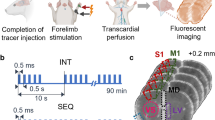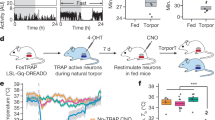Abstract
ALTHOUGH it is known that the hyperthermia in man accompanying steady-state submaximal exercise is a regulated rise which is virtually independent of the ambient temperature1, a fundamental question persists. What are the neural mechanisms involved in this regulated rise and in the ensuing hyperthermia encountered during severe work in the heat? It has been proposed that the elevation in the temperature set-point associated with fever has as its basic component a change in the hypothalamic balance between the essential cations, Na and Ca2 (refs 2, 3). Is it possible that such a mechanism could underlie the shift in temperature set-point which occurs during exercise? To explore this idea, we undertook two types of experiments. First, an artificial cerebrospinal fluid (CSF) containing excess Ca2+ ions was infused into the third ventricle. Secondly the kinetics of endogenous Ca2, as reflected by its retention or release into the third ventricle, was analysed. We report here that Ca2+ ions, acting directly on the brain, can indeed attenuate or entirely block the hyperthermia of exercise without necessarily interfering with work output; further, the actual efflux of Ca2+ ions from the diencephalon increases markedly during the exercise-induced hyperthermia.
This is a preview of subscription content, access via your institution
Access options
Subscribe to this journal
Receive 51 print issues and online access
$199.00 per year
only $3.90 per issue
Buy this article
- Purchase on Springer Link
- Instant access to full article PDF
Prices may be subject to local taxes which are calculated during checkout
Similar content being viewed by others
References
Nielsen, M. Skand. Arch. Physiol. 79, 193–230 (1938).
Myers, R. D. & Veale, W. L. Science 170, 95–97 (1970).
Myers, R. D. in Recent Studies of Hypothalamic Function (eds Lederis, K. & Cooper. K. E.), 371–390 (Karger, Basel, 1974).
Johnson, G. S., Elizondo, R. S. & Mizell, S. Fedn Proc. 1952 (1976).
Gisolfi, C. V., Myers, R. D., Mora, F. & Nattermann, R. A. J. appl. Physiol. (in the press).
Myers. R. D. Physiol. Behav. 2, 373–377 (1967).
Myers, R. D. in Method in Psychobiology (ed. Myers, R. D.), 27–65 (Academic, London, 1971).
Sobocinska, J. & Greenleaf, J. E. Am. J. Physiol. 230, 1416–1419 (1976).
Gisolfi, C. V., Wilson, N. C., Myers, R. D. & Phillips, M. I. Brain Res. 101, 160–164 (1976).
Author information
Authors and Affiliations
Rights and permissions
About this article
Cite this article
MYERS, R., GISOLFI, C. & MORA, F. Calcium levels in the brain underlie temperature control during exercise in the primate. Nature 266, 178–179 (1977). https://doi.org/10.1038/266178a0
Received:
Accepted:
Issue Date:
DOI: https://doi.org/10.1038/266178a0
Comments
By submitting a comment you agree to abide by our Terms and Community Guidelines. If you find something abusive or that does not comply with our terms or guidelines please flag it as inappropriate.



